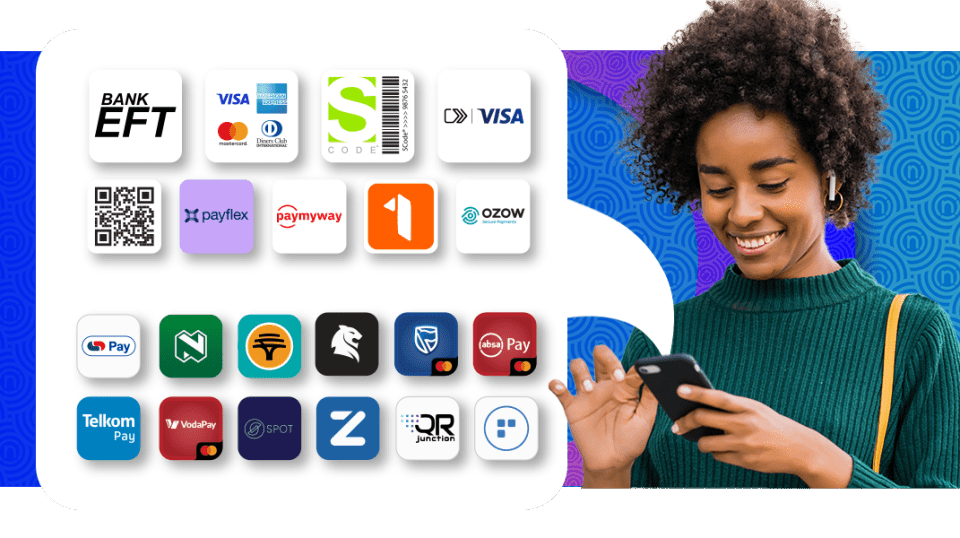
Payment solution for the accounting industry
August 15, 2025
Introducing Zapper to enhance customer experience & drive loyalty
August 15, 2025Are you aware of how fast-paced business has become in South Africa? Waiting 24 to 48 hours for payments to clear just doesn’t cut it anymore, especially when you’re paying salaries, suppliers, or contractors. That delay can hold back everything, from deliveries to employee satisfaction.
PayShap changes the game. As South Africa’s real-time payment solution, it lets you make outward payments instantly, using just a mobile number. Whether you’re managing payroll or paying suppliers, PayShap helps you stay in control of your cash flow and cut unnecessary costs. Its instant payment method makes it a must-have business feature, not an alternative.
PayShap is South Africa’s instant interbank payment system. Send money in seconds using an account number or ShapID (mobile number). It runs 24/7, shows the recipient name before you pay, and is supported by major banks (Absa, FNB, Standard Bank, Capitec, Nedbank, Discovery, African Bank, TymeBank).
This guide breaks down why instant payments are no longer a nice-to-have, how PayShap works, and how your business can start using it to save time and money. Let’s dive in!
Ready to experience the Pay Now difference?
Experience seamless payments for your business with the support of a trusted partner.
Why instant payments are a business imperative
If you’re still relying on traditional EFTs or scheduling payments based on banking hours, you’re limiting your agility.
Instant payments give you the freedom to move funds anytime, respond to urgent needs, and avoid delays. When a supplier requires immediate payment to release stock, or a contractor finishes a project on a weekend, being able to pay on the spot keeps your operations smooth.
From logistics to retail to professional services, instant payment capability builds trust with staff, partners, and customers. It also helps you avoid late payment penalties, keep payroll on time to maintain staff gratification, and take advantage of early payment discounts from suppliers.
How does PayShap work? A business-friendly overview
PayShap is a real-time, interbank electronic payment service launched by BankservAfrica and backed by the South African Reserve Bank. It enables you to send money instantly, usually in under 10 seconds, using bank account details or just a mobile number, known as a ShapID.
PayShap shows you the recipient’s registered name before you approve, reducing misdirected payments and fraud risk.
So, using a recipient’s banking details is not the only way to pay them. As long as their mobile number is linked to their account via a participating bank, they can receive funds directly and immediately. Recipients can also send a payment request, which is reflected instantly once approved.
Participating banks include Absa, FNB, Standard Bank, Capitec, Nedbank, Discovery, African Bank and TymeBank.
The system is designed for speed, simplicity, and security. It’s available 24/7, even after hours and on weekends.

Benefits of processing immediate payments with PayShap
Here’s what makes PayShap especially useful for businesses that handle outward payments.
Immediate payment processing
Whether you’re paying salaries, service providers, or reimbursements, PayShap ensures funds reflect in seconds, enhancing operational efficiency.
You no longer have to factor in bank cut-off times or wait for a new business day. That’s a huge advantage if your business involves casual labour, urgent services, or international timelines.
If a contractor finishes a job at 8 p.m. on a Sunday, you can pay them immediately; there is no need to wait until Monday morning.
24/7 availability
PayShap operates around the clock, every day of the year.
This flexibility is crucial for businesses that work outside the traditional 9 to 5 window. If you’re in hospitality, emergency repairs, transport, or eCommerce, you can settle and receive payments after hours without a hitch.
No more scheduling payroll around public holidays or waiting for a banking window to open. With PayShap, your money moves when your business does.
Enhanced cash flow management
Because payments reflect instantly, you gain real-time insight into your available funds. This helps you manage cash flow more actively and enables quicker reinvestment into operations.
Let’s say you run weekly payouts to casual workers. With PayShap, you’ll know exactly when the money has left your account and when it’s been received, helping you plan the next payments or expenses without playing guessing games.
Plus, suppliers are more likely to offer favourable terms when they know you can pay them immediately.
Cost-effective transactions
Traditional EFT and batch payments can rack up fees at volume; PayShap’s per-payment pricing is often lower for small, urgent payouts. PayShap is a more affordable alternative. Imagine saving just a few rands per transaction across hundreds of monthly payments. Over a year, that adds up to a noticeable chunk of change. PayShap fees vary across the participating banks, but more on that later.
Simplified payment processes
Forget collecting and verifying bank account details. PayShap uses mobile numbers (ShapIDs), making it quicker and less error-prone.
This is especially useful if you pay once-off contractors or suppliers who aren’t set up in your accounting system yet. Just get their mobile number and pay them directly. It also saves your finance team time, no more double-checking account numbers or chasing recipients for details.
Integration with business systems
Enable PayShap via Netcash to plug it into payroll, accounting, or ERP workflows with audit trails, roles/permissions and easier reconciliation.
You can run PayShap payments from your payroll, accounting, or Enterprise Resource Planning (ERP) software. Whether it’s Sage, Xero, QuickBooks, or a custom system, payment solution providers such as Netcash can offer plug-and-play integrations that simplify setup and ensure compliance. This means fewer errors, improved reporting, and faster reconciliation.
Don't know where to start when choosing the right payment methods for your business?
Speak to our Payments Advisors, we'll know what to do.
Challenges in adopting PayShap: what businesses should know
As with any new system, switching to PayShap comes with a few initial hurdles. The good news? They’re manageable if you know what to expect. Here are a few things to keep in mind.
Initial tech integration hurdles
Some businesses may face compatibility issues when trying to connect PayShap to their existing systems. This is where using a payment solution partner substantially helps; they handle the backend and offer integration support, so you’re not left to figure it out alone.
Staff training and awareness gaps
Your finance and payroll teams might need some time to get used to ShapIDs and instant transaction flows. Simple training can go a long way, show them how PayShap works, how to verify recipient names, and how to reconcile payments on the same day.
Customer uptake
If you’re paying contractors or suppliers who aren’t yet familiar with PayShap, they might hesitate to provide a mobile number instead of bank details. Education is key here. Let them know that the system is backed by major banks, such as FNB, Absa, and Standard Bank.
Explain how linking a mobile number to their account is secure and straightforward.
Bank limitations
Bank coverage is broad and growing; check which accounts at your bank can send and receive PayShap (limits and fees can differ by account type). In addition to the three major banks mentioned above, PayShap also works with Capitec, Nedbank, Discovery, African Bank, and Tymebank.
Check with your bank to see which accounts can send and receive PayShap transactions.
Security concerns
Some business owners worry about fraud or errors when using mobile numbers instead of account numbers. But PayShap includes a verification step: you’ll always see the recipient’s registered name before completing a payment.
And when used through payment solution providers such as Netcash, payments are backed by strict controls, user permissions, and audit trails, giving you full visibility and peace of mind.

In practice, small ShapID payments are often R0–R7.50 at major banks, with free tiers in some cases; fees rise with value or if you pay to an account number.
PayShap fees across South African banks
Transaction fees for PayShap vary significantly by bank, transaction size, and whether the payment uses a ShapID or a regular account number. Understanding how PayShap transaction charges differ from bank to bank can help you make smarter decisions for your business.
Here’s a quick overview of typical fees for outward payments using a ShapID:
|
Bank |
Up to R100 |
R100+ to R200 |
R200+ to R1,000 |
R1,000+ to R3,000 |
Notes |
|
Absa |
Free |
R2.50 |
R7.50 |
R4.50 |
R7.50 to bank accounts; up to R45 for large transactions |
|
FNB |
Free |
R6.00 |
R6.00 |
R6.00 |
Free FNB-to-FNB; R0.65/R100 after first R100 to other banks |
|
Nedbank |
Free |
R1.00 or R7.50 |
R1.00 or R7.50 |
R1.00 or R7.50 |
R1.00 ShapID to ShapID
R7.50 to bank account |
|
Standard Bank |
R1.00 |
R7.00 |
R7.00 |
R50.00 (R2,000 and above) |
Fees rise with payment size |
|
Discovery Bank |
R1.00 |
R5.00 |
R5.00 |
R5.00 (up to R1,500) |
0.4% of the transaction amount, capped at R30 for transactions between R1,500 and R3,000 |
|
Capitec |
Free |
R1.50 |
R1.50 |
R3.00 |
Lower fees Capitec-to-Capitec |
|
TymeBank |
Free |
Free |
Free |
Free |
All PayShap transactions are free |
Cards are great for consumer checkout but pricier for payouts; PayShap is built for instant account-to-account disbursements in ZAR.
Does PayShap sound like a payment method that would suit your business?
Speak to one of our Payments Advisors to learn more.
How South African businesses are using PayShap in practice
Businesses across industries are already tapping into the power of PayShap.
- Retailers are using it to pay part-time staff after weekend shifts
- Logistics companies send same-day payouts to delivery drivers
- Event agencies settle invoices with freelance technicians on-site
- Maintenance teams use it for reimbursing staff on the road
These aren’t edge cases. They’re everyday solutions that your business could also benefit from.
How PayShap compares with EFTs, cards, and global systems
Let’s put PayShap side-by-side with other common payment methods.
|
Feature |
PayShap |
EFT |
Debit/Credit Card |
Global Instant (e.g., UPI, Pix) |
|
Speed |
Instant (seconds) |
1–2 business days |
Real-time |
Instant |
|
Availability |
24/7 |
Banking hours only (with instant options) |
24/7 |
24/7 |
|
Recipient ID needed |
Mobile number |
Bank account number |
Card number |
Varies (e.g., UPI ID) |
|
Cost per transaction (depends on service provider) |
Low |
Medium–High |
Medium |
Low–Medium |
|
Business system integration |
Yes |
Yes (but limited) |
Limited |
Varies |
While bank EFTs are still common, they simply can’t compete with the flexibility and speed of PayShap. Debit and credit card payments tend to be faster than traditional EFTs, but these payment processes come with higher fees and more complexity around reconciliation.
Globally, systems like India’s UPI or Brazil’s Pix are leading the shift to real-time payments. PayShap is South Africa’s answer, and it’s built for scale.
Getting started: What you need to enable PayShap for your business
Ready to make the move? Here’s what to do:
- Choose a payment solution partner:
Use a payments partner such as Netcash or a participating bank of your choice to enable PayShap across your payroll and accounts systems with full integration and support.
- Verify recipient information
Ask staff, freelancers, or suppliers to link their mobile number to a supported bank account. Make sure their ShapID is verified.
- Train your team
Ensure your finance team knows how to load, track, and reconcile PayShap payments.
- Test and optimise
Start with a small batch. Monitor results and tweak processes where needed.
- Communicate benefits
Let your recipients know payments are faster and safer, and build trust through transparency.

FAQs about using PayShap for efficient payment processing
Here are some answers to the most frequently asked questions about using PayShap.
Conclusion: Why PayShap is a smart business move
In a world where speed and efficiency can make or break your business, PayShap offers a simple way to stay ahead. By embracing real-time payments, you reduce delays, cut costs, and improve trust with everyone you pay, from your staff to suppliers.
Better yet, when you use PayShap through a trusted payments provider like Netcash, you get full control, smart integrations, and a secure, scalable solution that grows with your business.
Don’t wait for the future of payments to arrive; it’s already here.
Ready to make the move to online payments?
Speak to us about PayShap and our other convenient online payment methods today.

With a wealth of experience and a strategic vision that transcends boundaries, Liana Clarke is the architect of our marketing success story. Their leadership style is a perfect blend of inspiration and strategic acumen, guiding our team through the ever-changing landscape of consumer preferences and market trends.



